Petunias are a group of flowering plants that belong to the Nightshade family. The genus Petunia contains around 35 species, most of which are annual herbs. The Common Garden Petunias (Petunia × atkinsiana also known as Petunia x hybrida), are the most well-known from this group, and while they are technically perennials, the majority of gardeners grow them as annuals.
Petunias flowers are particular garden favorites due to their bright and bold coloring, and their large number of reliable blooms. Whether for sunny borders, patio containers, or hanging baskets, Petunia plants have a wide range of growth habits, so whatever the requirement, there is a variety to fulfill the need.
History
Native to South America, Petunia plants were first discovered in the late 1700s by explorers. However, it was not until after World War II that the first Petunia hybrid was bred, leading to the hundreds of named varieties we have today.
Petunias have showy, trumpet-shaped flowers with five fused or partially fused petals. Most are insect-pollinated, although some such as P. exserta, a rare Brazillian species, are pollinated by hummingbirds.
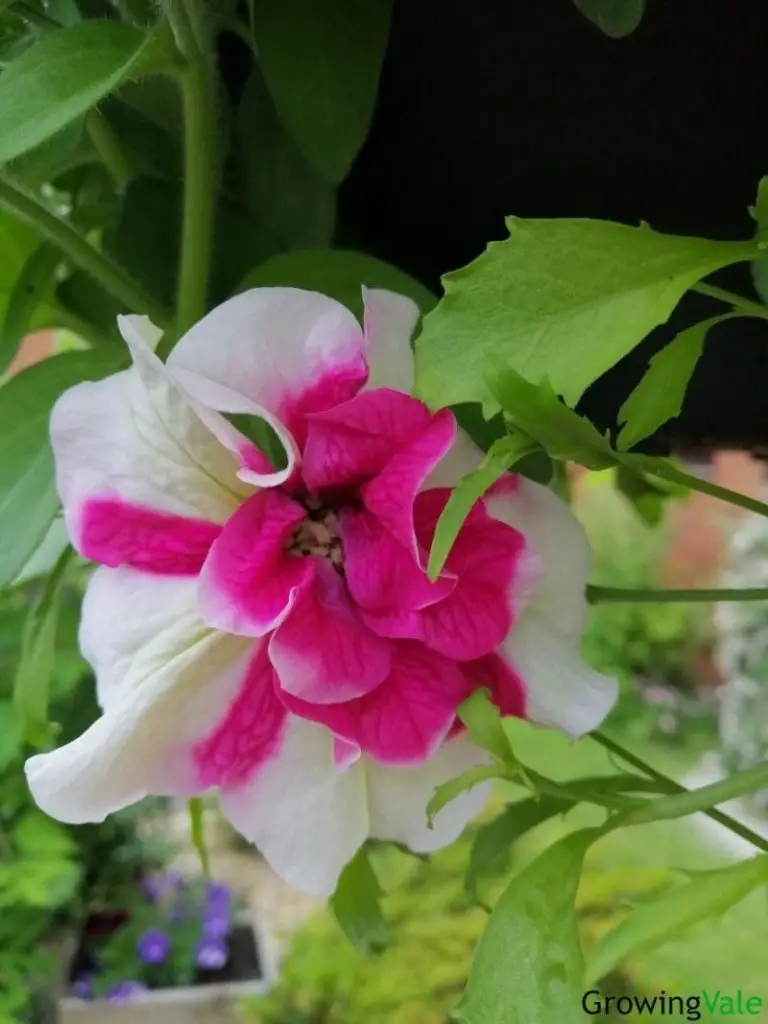
Modern-day varieties and cultivars (P. x atkinsiana) come in a vast range of colors, including white, pink, red, yellow, orange, purple, blue, and even black. These modern-day garden favorites fall into 4 distinct categories; Grandiflora (large flowers), multiflora (many flowers), milliflora (small flowers and plants), and “spreading” (fast-growing). Additionally, there are single or double bloom varieties.
Plant Facts
| Scientific name | Petunia spp. |
| Common names | Petunia, Common Garden Petunia |
| Genus | Petunia |
| Family | Solanaceae |
| Height | 0 ft. 6 in. – 1 ft. 6 in. |
| Width | 1 ft. 0 in. – 3 ft. 0 in. |
| USDA Plant Hardiness Zone | 10a, 10b, 11a, 11b |
| Origin | South America |
| Flower colors | White, Pink, Red, Yellow, Orange, Purple, Blue, Black |
| Blooming season | Late spring-fall |
| Plant/Flower special features | Showy, numerous, trumpet-shaped flowers |
How to Plant and Grow Petunias
Plant Petunias once the danger of frost has passed and soil temperatures are over 60°F. They can tolerate poor soil but require sufficient sunlight. Petunias can be grown indoors in pots, but make sure to put them in a sunny spot and keep an eye on them.
After the first few days of transplanting, plan to provide extra protection from the midday sun if the weather is particularly hot.
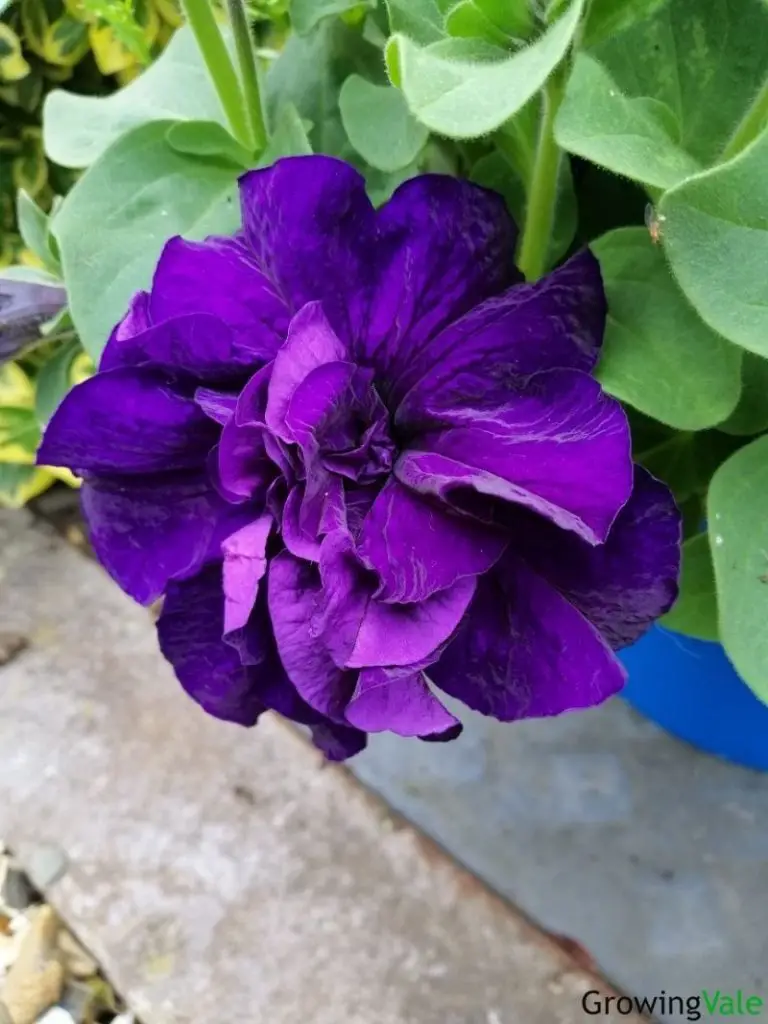
Growing Petunia Flowers in a Bed
Prepare the soil before planting, amending clay or sand types if required. Dig holes wide and deep enough to house roots and gently place in the plants or seedlings. Cover with soil and water well to settle in.
Space Grandiflora and multiflora types at least 12 inches apart if grown in full sun. Those in shadier locations can be spaced closer together. Milliflora types should be 4-6 inches apart, whereas spreading types should have at least 1-1.5 feet of space between them.
Growing Petunia Flowers in a Pot
To grow Petunias in containers, use a light-weight and well-draining potting mix. Petunias are susceptible to root rot and therefore cannot tolerate prolonged wet conditions. Ensure the container has enough drainage holes.
Petunias flowers grown in containers will need to be spaced closer together than recommended for bed planting, as it is important to achieve a full and beautiful container display straight away.
Consider what plants (if any) would make attractive companion plants for your pot. African Daisies have similar care needs and reach taller heights, giving an interesting 3-dimensional display. Plants with contrasting colors would also be a good match.
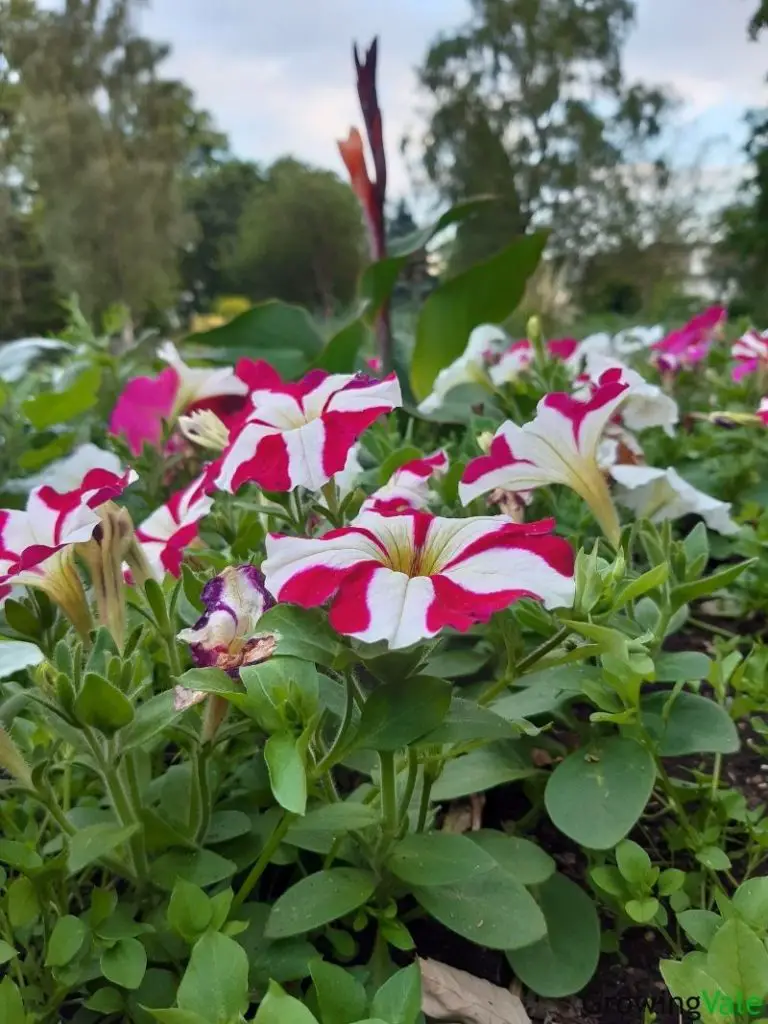
How to Propagate Petunia Plants
Petunias are normally purchased from nurseries, ready to be transplanted to the garden; they can be propagated at home from seeds or cuttings, but this may require special equipment. Propagation from seeds is the recommended method of the two, yet this method can be a challenge even for experienced gardeners.
Propagation from Seed
Start seeds indoors in early March as it will take 10-12 weeks before new plants are large enough to be transplanted outdoors.
Spread seeds sparingly on top of a tray with damp potting soil. Press them gently into the soil before watering. Cover them with a plastic lid and place the tray in a warm, bright place and out of direct sunlight at 70-85°F.
Once seedlings emerge (usually 7-10 days), remove the lid and relocate seedlings to a cooler, bright spot with nighttime temperatures of 55-65°F. Place them 4-6 inches under a fluorescent light for 16-18 hours daily until they are ready for transplantation. As plants grow, adjust the light source so space above is always 4-6 inches.
When plants have 3 true leaves, move them into individual containers or divided planter trays. Feed plants every two weeks with liquid fertilizer (weekly for spreading types), and harden them off before transplanting by putting them outside on warm sunny days.
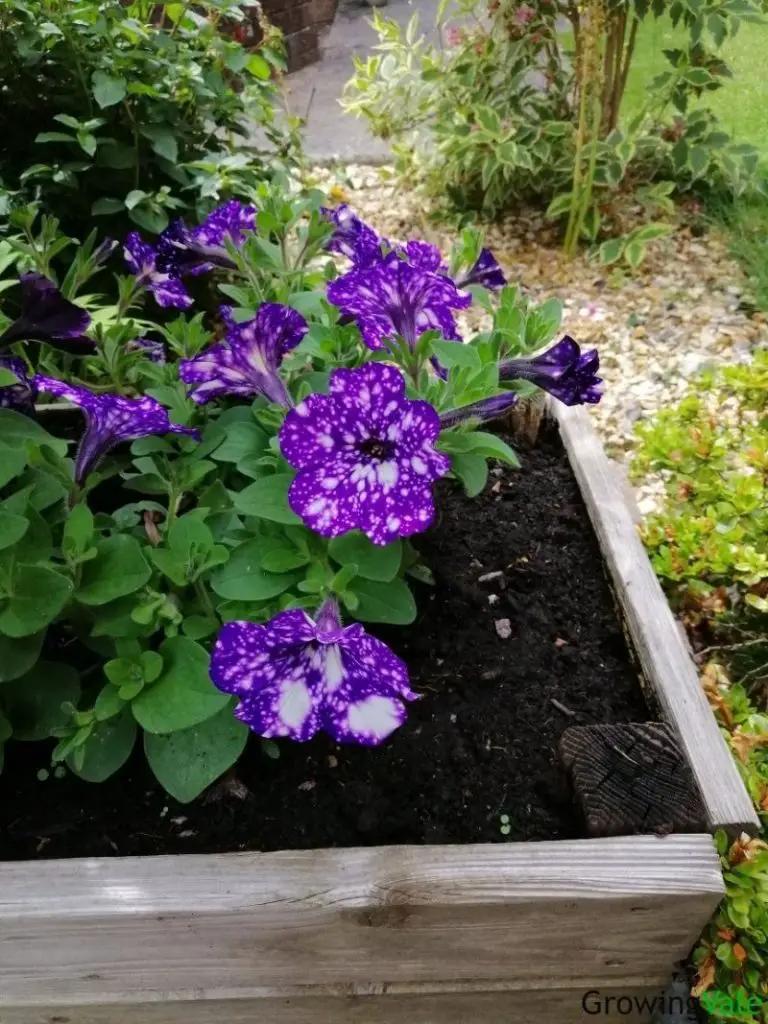
Propagation from Cuttings
To propagate from cuttings, take softwood cuttings from Petunia plants in spring or summer from new growth, using a non-flowering shoot as it will root more easily. Take a 2-4 inch cutting below a leaf node, remove the lower leaves and dip the end in rooting hormone.
Place the cuttings gently into pre-made holes in a tray of seed or cutting compost. Leave the first pair of leaves sitting just above the soil line. Water to settle in. Put the tray into a propagator case with a base temperature of 64-75°F. Covering the tray with a plastic bag is a suitable substitute, but remove the bag bi-weekly for 10 minutes for ventilation.
Place in a bright spot with indirect sunlight. Keep the compost moist and wait for rooting to take place (usually 2-4 weeks). After this, harden off cuttings for two weeks before transplantation, by increasing ventilation so plants can tolerate lower humidity environments.
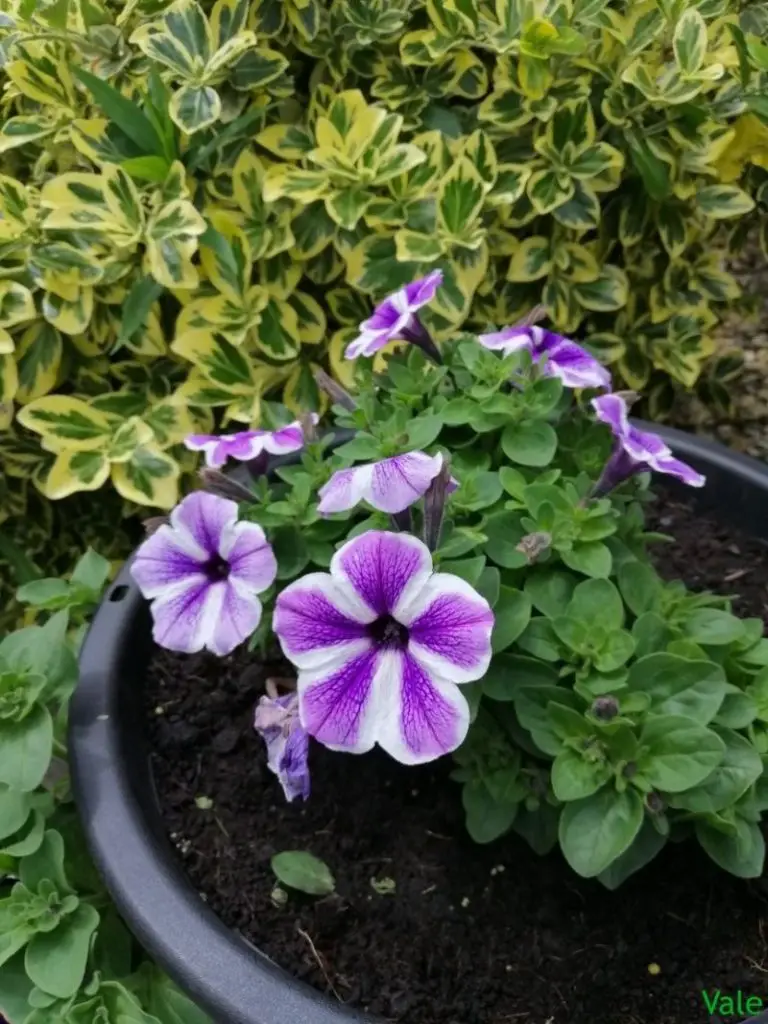
Care and Maintenance
Soil
Petunia plants are not particularly fussy about rich, fertile soil, but require well-draining soil for them to grow well. Improve aeration in clay soil types, and water retention in sandy soils, by amending beds with peat moss, compost, or well-rotted manure.
Water
These plants are fairly drought tolerant, but water once a week, ensuring a thorough soaking of 6-8 inches deep. Keep an eye on spreading types as these will require more water. Allow the soil to dry out between waterings.
Petunia flowers that are grown in containers, hanging baskets, or window boxes will require more regular watering, even as frequently as daily. However, this is dependent on container size and soil volume.

Fertilizer
Petunias grown in beds, containers, and spreading types have different fertilizer needs.
For garden bed plants, add a balanced fertilizer into the soil before planting. This should be at a rate of 2 pounds per 100 square feet. From early to mid-July, begin adding a liquid fertilizer every 3 weeks.
Plants grown in containers should have timed-release fertilizers added to the soil before planting, then regular liquid fertilization every two weeks from early to mid-July.
For spreading types grown either in beds or containers, follow the above recommendations, but use a liquid fertilizer weekly from early to mid-July.
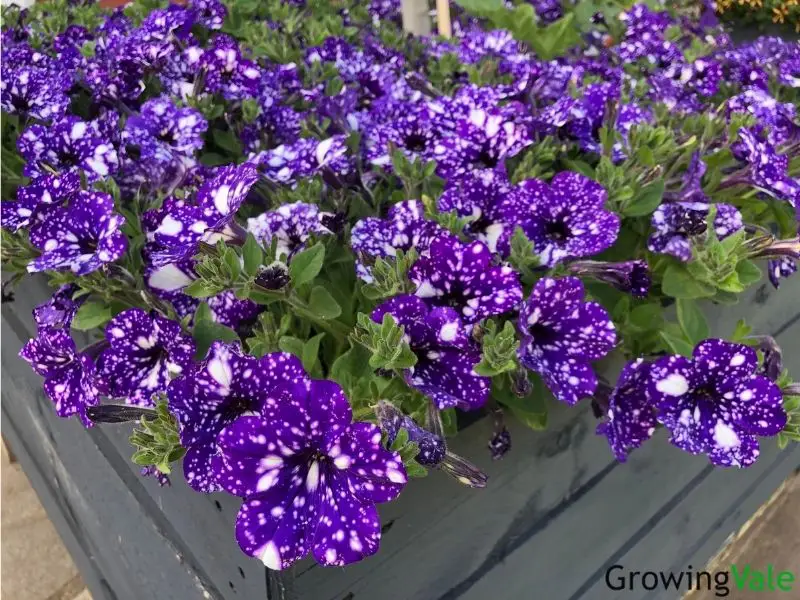
Sunlight
Petunias prefer and perform better under full sun. Those grown under shady conditions will produce fewer blooms, so plant them where they will get at least 5-6 hours of direct sunlight per day.
Temperature and Humidity
Petunia plants are winter hardy to USDA zones 10-11, but in cooler areas they can be grown as annuals rather than perennials. They are heat and drought-tolerant. In colder climates, consider frost-hardy varieties.
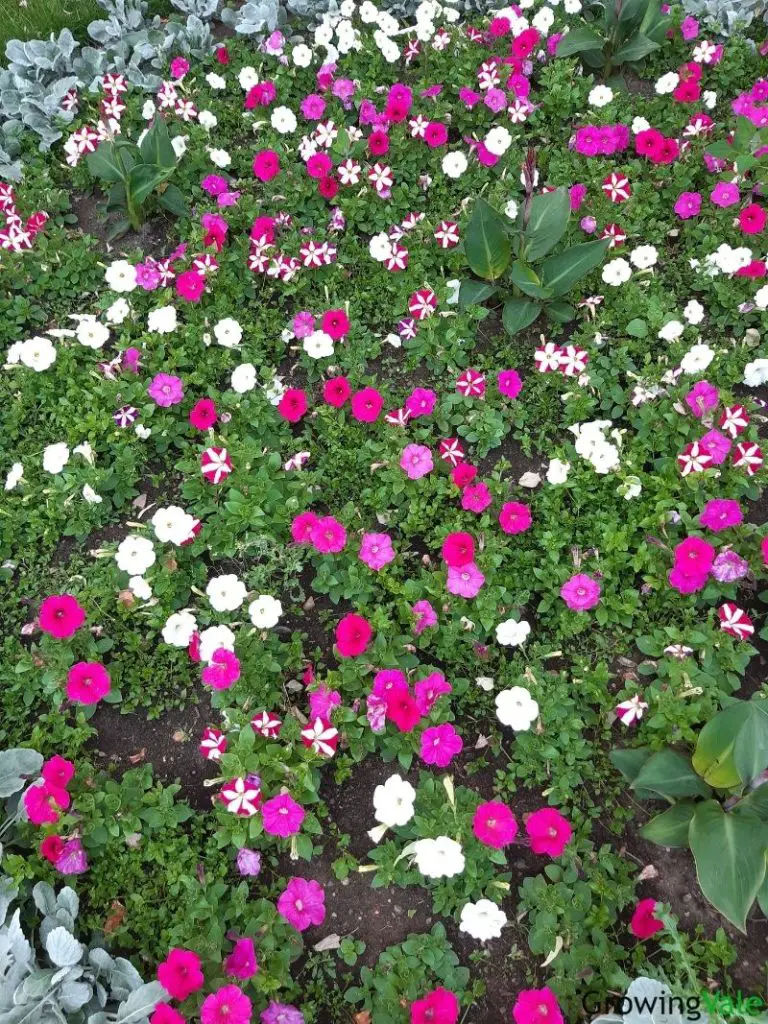
Pest and diseases
Petunias are susceptible to root rot, gray mold, and tobacco mosaic virus.
They are deer resistant, but pests to watch out for are aphids, slugs, and snails. Regular scouting of plants can help to limit infestations. Apply a horticultural/insecticidal soap to treat aphids, or prune infected branches.
Pruning
If practical, deadhead spent Petunia flowerheads to encourage blooming and to keep the plant looking healthy overall.
Pinch back leggy plants to promote bushier, more attractive growth. Grandiflora and multiflora types should be pinched back once they reach 6 inches tall to encourage rapid formation and growth of flowering side shoots. Spreading or milliflora types should not be pinched back.
Uses of Petunias
Petunias, specifically the modern hybrids and cultivars, are extremely popular as ornamentals in the garden. Their ability to grow extremely well in containers, pots and hanging baskets lends them in particular to city gardens and patios. Spreading varieties are also particularly popular in parks and public gardens.
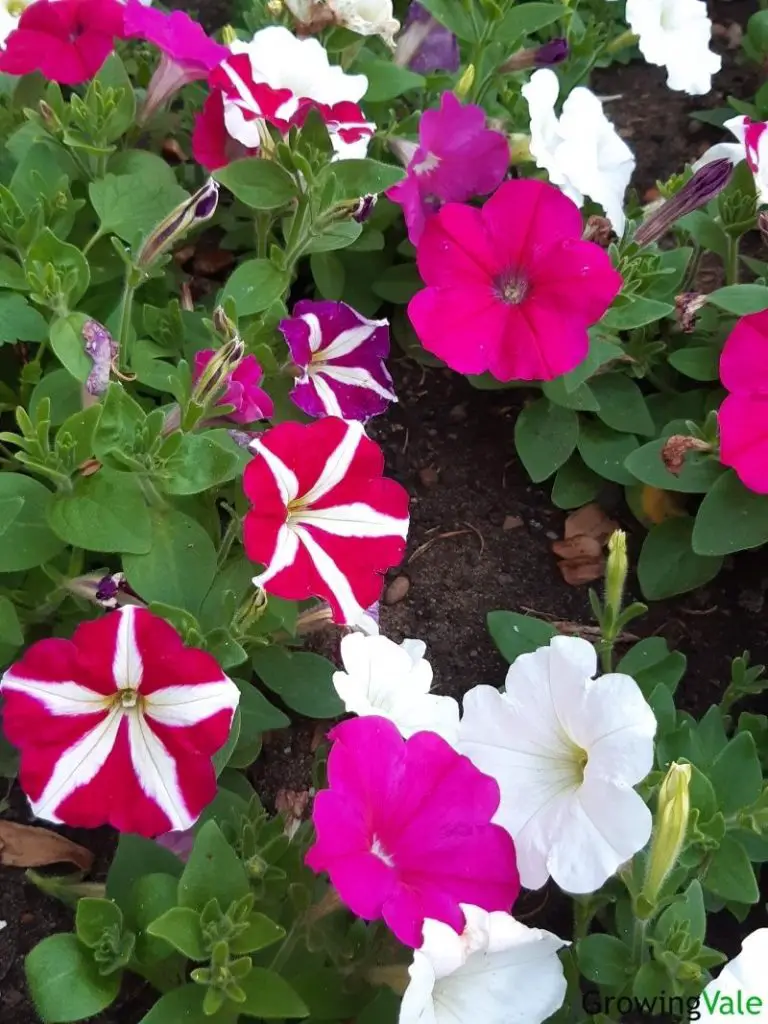
Common Varieties and Cultivars
There are hundreds of Petunia flower varieties and cultivars, each as lovely as the next. Below is a list of popular choices with different attributes and growing needs to suit any garden environment:
- Night Sky – a mound growing type with purple flowers flecked with creamy-white dots. Perfect as a stand-alone plant in a container.
- Shock Wave Denim – a spreading variety with small 1-2 inch dark blue-purple blooms. Plant them in sweeping drifts for groundcover.
- Storm Pink – a bushy cultivar with baby pink and white-throated flowers, that looks lovely in sunny borders in cottage-style gardens.
- Surfinia Double Blue Star – a great variety for hanging baskets, these double, blue-purple flowers look stunning tumbling over container edges to the ground.
- Sweetunia Johnny Flame – another great choice for hanging baskets, this “self-cleaning” plant doesn’t require deadheading and has large, burgundy blooms with hot pink edges.
Conclusion
Petunias are about 35 species of flowering plants which belong to the Nightshade family. First discovered in the late 1700s by explorers in South America, modern-day varieties and cultivars such as the Common Garden Petunia are extremely popular plants and grown as annuals in colder climates.
They can be propagated from seed or by softwood cuttings, however, their popularity means purchasing ready to transplant Petunias from nurseries is easy and cheap. Depending on the variety, Petunias make fantastic plants for containers, hanging baskets, window boxes, and sunny borders.
With hundreds of beautiful varieties to choose from, finding the right Petunia to suit your needs is easy. Their bright and colorful trumpet-shaped flowers and numerous blooms make them a garden favorite every year!
See more: Petunia Flower Meaning and Symbolism

